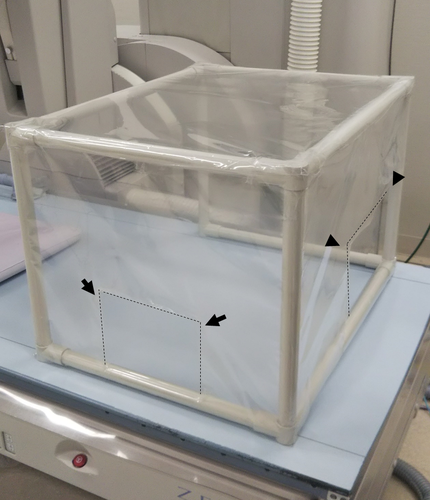-
Home
-
About JCTR
-
Gold Open Access
-
Issues
-
Editorial board
-
Author guidelines
-
Publication fees
-
Online first
-
Special issues
-
News
-
Publication ethics
-
Partners
-
Submit your manuscript
-
Submit your review report
-
Editorial Office
-

This work is licensed under a Creative Commons Attribution-NonCommercial 4.0 International License. ISSN print: 2382-6533 ISSN online: 2424-810X
Volume 6 Issue 6
A box-shaped, shielding device for reducing the risk of COVID-19 droplet infection during gastrointestinal endoscopic procedures
Hideaki Kawabata*, Yuji Okazaki, Kazuhisa Watanabe, Takato Inoue, Katsutoshi Yamaguchi, Yuki Ueda, Misuzu Hitomi, Masatoshi Miyata, Shigehiro Motoi
Kawabata et al. J Clin Transl Res 2020; 6(6):1
Published online: December 11, 2020
Abstract
Background and Aims. Endoscopists and endoscopic assistants are easily exposed to germs, including COVID-19, during aerosol-generating procedures such as gastrointestinal endoscopy. This retrospective study investigated the utility of a box-shaped, shielding device for reducing the risk of COVID-19 droplet infection during endoscopic procedures.
Methods. We created a cuboid box (500 × 650 × 450 mm), with four sides were covered with a transparent, vinyl-chloride sheet having two windows for endoscopic passage and assistance. The shielding box was then placed over a patient’s head and shoulders and covered with another transparent vinyl sheet. We assessed its utility and safety using the medical data concerning the procedure time and vital signs and a questionnaire for the endoscopic staff and patients.
Results. We performed endoscopic retrograde cholangiopancreatography-related procedures using this device for two patients suspected of having COVID-19-associated pneumonia. Both patients were smoothly and successfully treated without any complications. No difficulties were noted with either endoscopic operation or in assisting the procedure, and the transparency was good enough to observe the patients’ faces and movements.
Conclusions. This box-shaped, shielding device can be used to reduce the risk of COVID-19 droplet infection during endoscopic procedures in the clinical setting.
Relevance for patients. The COVID-19 outbreak has reminded healthcare personnel working in endoscopy units of the importance of infection prevention during endoscopy. The box-shaped, shielding device device can help endoscopic staff avoid hospital-setting COVID-19 infection.

DOI: http://dx.doi.org/10.18053/jctres.06.202006.001
Author affiliation
Department of Gastroenterology, Kyoto Okamoto Memorial Hospital
*Corresponding author
Hideaki Kawabata
Kyoto Okamoto Memorial Hospital, 100 Nishinokuchi, Sayama, Kumiyama-cho, Kuze-gun, Kyoto 613-0034, Japan
TEL: +81774 48 5500
FAX: +81774 44 7159
E-mail: hkawabata@okamoto-hp.or.jp
Handling editor:
Michal Heger
Department of Pharmaceutics, Utrecht University, the Netherlands
Department of Pharmaceutics, Jiaxing University Medical College, Zhejiang, China

